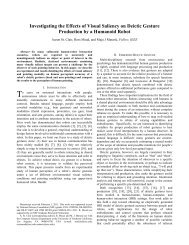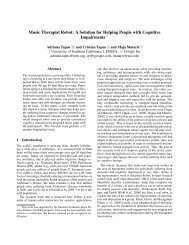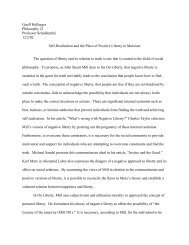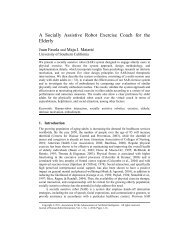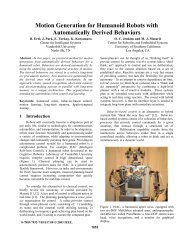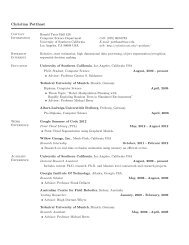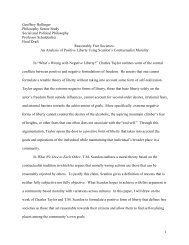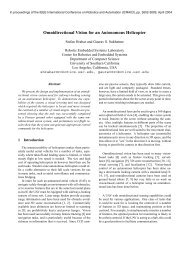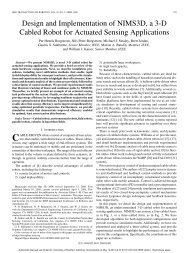A Scalable Approach to Human-Robot Interaction - USC Robotics ...
A Scalable Approach to Human-Robot Interaction - USC Robotics ...
A Scalable Approach to Human-Robot Interaction - USC Robotics ...
Create successful ePaper yourself
Turn your PDF publications into a flip-book with our unique Google optimized e-Paper software.
odometry for laser beacon-based localization andnavigation. The sonar is used for obstacle avoidance.The first system is a multi-robot, multi-target trackingsystem [9], configured <strong>to</strong> detect three different targetsidentified by colored beacons. Hence, three services aregenerated and provide target location information. For theexperiments, the system consists of three robotsconfigured <strong>to</strong> be either stationary or dynamic trackers.Using the infrastructure, the system client can manage up<strong>to</strong> 10 requests simultaneously.The second system offers one service and consists of adelivery robot that navigates <strong>to</strong> goal locations provided bythe requesting user. It provides task status details ofproximity <strong>to</strong> the goal location and the robot’s currentpose. A new goal location can be entered at any time. Thedelivery robot has a ‘home’ location in an office where itreturns <strong>to</strong> whenever it is not tasked. For long durationexperiments, this location could contain a docking stationfor recharging.The two systems share the same environment map andcoordinate reference frame so location information iscommon between them. This map was used in the earliersimulation experiments. No calibration had <strong>to</strong> be carriedout for real robot localization, which is a testament <strong>to</strong> theaccuracy of the map used in Stage and the effectiveness ofusing Stage for real robot system development.Experiment 1 – Small Scalability AnalysisThe first experiment involves several users requestingtasks from the systems. The three tracking robots areconfigured <strong>to</strong> act as stationary sensors. The area of thetracking system’s coverage is shown by the gray areas inFigure 3. The target <strong>to</strong> be tracked is the delivery robotwhich is tasked through the infrastructure <strong>to</strong> travel <strong>to</strong>locations in the corridors within the tracking system’scoverage.The infrastructure operates as follows. The systemsconnect <strong>to</strong> the infrastructure, register their services andwait for requests. The users connect <strong>to</strong> the infrastructureand receive the global list of services, consisting of thethree tracking services for the differently colored targetsand one delivery service. The users select whicheverservice they desire and are connected <strong>to</strong> the applicablesystem. They then have a one-<strong>to</strong>-one interaction for eachsystem they are connected <strong>to</strong>. Additionally, they retainaccess <strong>to</strong> the global service list for many-<strong>to</strong>-manyinteraction.The experiment ran for approximately 50 minuteswith 10 users connecting <strong>to</strong> the infrastructure andperiodically requesting and terminating services. Figure 4shows the server’s performance during the experiment.The data shown represents the time for the server <strong>to</strong>process service request, list request, and servicetermination messages. The instantaneous number ofonline users is also shown. As can be seen, the number ofusers has little effect on the response times. The mainreason for this is that the infrastructure’s operations areevent-based on the user’s side. Therefore, connected usersrequire no maintenance when there is no activity. On thesystem side, a ping signal is sent from the server every 20seconds <strong>to</strong> ensure all systems connected <strong>to</strong> it are stillserviceable. A system has 10 seconds <strong>to</strong> respond before itand its services are removed from the server.50454035302520151050RequestListTerminate#Users1 306 610 913 1217 1522 1828 2132 2436 2739 3044Time (s)Figure 4. Server response times for Experiment 1. The numberof users connected at any point in time is represented by thesolid line and the right y axis. The server’s response times <strong>to</strong> thevarious messages are shown by the symbols and correlate <strong>to</strong> theleft y axis.While the server’s response times <strong>to</strong> requests provideevidence of its efficiency, the response times from theuser’s perspective provides a better indication <strong>to</strong> theefficiency of the infrastructure. In addition <strong>to</strong> the timetaken by the server <strong>to</strong> process the requests, thecommunication delays between infrastructure layers,system client processing times and UDP packet queueprocessing can also contribute <strong>to</strong> these response times.Table 1 lists the statistics pertaining <strong>to</strong> requests forservices and service lists. These constitute the two mosttime-intensive messages used in the infrastructure. Thetimes are measured from when the user made the request<strong>to</strong> when a response was received which is either from theserver if the request is refused or from the system <strong>to</strong>commence interaction.Table 1. Statistics from the user’s perspectiveService ListRequestsServiceRequestsNumber of Requests 30 19Maximum Response Time 170 ms 64 sMedian Response Time 43 ms 691 msMinimum Response Time 5 ms 38 ms1210864201668
Requests for the global service list from the server aregenerally carried out quickly since the transactioninvolves only the user clients and the server. Requests forservices take longer since they are processed by the serverand the system clients. Apart from the transition times, itmay take some time for the system client <strong>to</strong> respond <strong>to</strong> theuser’s request depending on its ongoing activities. For thetracking system, one robot was responsible for managingall users’ requests in addition <strong>to</strong> its tracking duties. As aconsequence of these duties and the limited processingcapability and memory on the robot, the response timessometimes <strong>to</strong>ok several seconds.The statistics for the service requests are listed inTable 2. The users selected 19 tasks, 14 of which weregranted. Three tracking service requests were refused due<strong>to</strong> the maximum quota of 10 simultaneous requests beingexceeded 1 . The system client notified the users in thesecases. Two request failures occurred due <strong>to</strong> the robotbeing overburdened with <strong>to</strong>o many requests <strong>to</strong> managesimultaneously. Although the maximum number ofrequests that the system client manages was set <strong>to</strong> 10, themaximum number the robot’s internal system couldreasonably sustain while carrying out its part as a trackerwas eight. During peak activity, eight users were beingmanaged by the tracking system for more than 20minutes, providing updates at 1 Hz.Table 2. Service statistics showing the number of tasks selectedand service running timesDeliveryServiceTrackingServiceNumber of Granted Tasks 3/3 11/16Maximum Time 1754 s 2057 sMedian Time 341 s 1478 sMinimum Time 185 s 2 sExperiment 2 – Service LinkingThe second experiment demonstrates the ability of theinfrastructure <strong>to</strong> link heterogeneous services <strong>to</strong> provide ahigher-level function <strong>to</strong> the user. It is similar <strong>to</strong> ourprevious service-linking experiment [17] except it iscarried out in a real building environment rather thansimulated open space.In this experiment, both tracking and delivery systemsare used. The tracking system provides users with thelocations of particular colored targets whereas thedelivery robot requires a location <strong>to</strong> deliver <strong>to</strong>. By linkingthese semantically similar services, a dynamic locationdelivery function is created. In this scenario, the deliverytarget is a person wandering around the environment.1 Even though there were only 10 users, a user could request morethan one task from a system if the system allows it.The robots are configured the same as Experiment 1,except one of the tracking robots is now mobile (T3 inFigure 3). Although this robot can traverse the wholeenvironment while searching and tracking, it is confined<strong>to</strong> the corridor where the stationary trackers are located.Once the systems and the infrastructure are connected,a user logs on and selects the target tracking service <strong>to</strong>determine whether the target is currently being tracked.Once it is, the user selects the linking option from theservice menu, which prompts for the data-providingservice and the command service. These are selected asthe applicable target tracking and delivery servicerespectively.The operation of the infrastructure at this point is thesame as if two separate services were selected. Bothconnect <strong>to</strong> the user client, which checks if the data serviceis part of a link. Since it is in this case, the information issent <strong>to</strong> the command service’s system client as well asbeing displayed <strong>to</strong> the user. The command service’ssystem client parses the received information for the goallocation. This effectively au<strong>to</strong>mates the user’s manualgoal location entry. Consequently, the delivery robot isconstantly provided with the updated target location. Inthe cases when the target is lost or there is no detectedlocation information in the data sent <strong>to</strong> the delivery robot,it proceeds <strong>to</strong> the last provided location. This helps dealwith temporary communication failures and target loss.Once the delivery robot is within a meter of the goallocation, it halts and sends a message <strong>to</strong> the user that it isat its commanded location.In this experiment, the tracking information issometimes provided by the mobile tracking robot, whichresulted in a two-robot convoy following the target. Thisapplication of a linked service could easily be extended <strong>to</strong>generate a leader-follower behavior for multiple robots ifthey need <strong>to</strong> be relocated en masse.5 ConclusionsIn the context of developing a scalable human-robotinteraction mechanism, we have assumed that the systemsinvolved have some degree of au<strong>to</strong>nomy. This assumptionallows a general and simple mechanism <strong>to</strong> be developed.Our interaction infrastructure follows this paradigm andallows users <strong>to</strong> interact with systems at two levels: many<strong>to</strong>-manyand one-<strong>to</strong>-one. The many-<strong>to</strong>-many level isrequired <strong>to</strong> expose the tasks or robots’ services <strong>to</strong> thehumans, and upon selection the users have more personalone-<strong>to</strong>-one interaction. These levels are expected <strong>to</strong> berequired in large scale robot applications such asassembling solar panels in space or robot-assisted searchfor casualties after an earthquake. The experimentspresented in this paper demonstrate the infrastructure’sapplication <strong>to</strong>wards these types of applications.1669
A future step for enhancing the infrastructure is <strong>to</strong>distribute the server <strong>to</strong> provide greater redundancy. Thiswill allow more robust operation in the presence of eithercommunication or server failures. Currently, if the serverfails, the infrastructure is unusable for new interactions,however any existing interaction between systems andusers remains unaffected.Establishing the potential numbers of systems andusers the infrastructure can support is important butlogistically difficult with real humans and systems. It canhowever, be analytically determined by developing aqueuing model from the infrastructure’s performance.Results obtained from the model can then be correlated insimulation.AcknowledgementsThis work is supported in part by the DARPA MobileAu<strong>to</strong>nomous <strong>Robot</strong> Software (MARS) Program undergrants DABT63-99-1-0015 and 5-39509-A (via UPenn),the DARPA Software for Distributed <strong>Robot</strong>ics (SDR)Program under contract 4400057784 (via SAIC), and theONR DURIP program under grant 00014-00-1-0638.Bibliography[1] A. Agah, "<strong>Human</strong> <strong>Interaction</strong>s with IntelligentSystems: Research Taxonomy", Computers andElectrical Engineering, 2001, no. 27, pp. 71-107.[2] K. Ali, and R. Arkin, "Integration of Reactive andTelerobotic Control in Multi-agent <strong>Robot</strong>icsSystems", Proceedings, From Animals <strong>to</strong> Animats 3:Simulation of Adaptive Behavior 1994, pp. 473-478,MIT Press.[3] R. Arkin, T. Collins, and Y. Endo, "Tactical Mobile<strong>Robot</strong> Mission Specification and Execution",Proceedings, SPIE-99, Mobile <strong>Robot</strong>s XIV, Bos<strong>to</strong>n,MA, September, 1999, pp. 150-163.[4] I. Elhajj, J. Tan, N. Xi, W. Fung, Y. Liu, T. Kaga, Y.Hasegawa, and T. Fukuda, "Multi-site Internet-basedCooperative Control of <strong>Robot</strong>ic Operations",Proceedings of the 2000 IEEE/RSJ InternationalConference on Intelligent <strong>Robot</strong>s and Systems,Takamatsu, Japan, 2000, pp.826-831.[5] A. Fox, B. Johanson, P. Hanrahan, and T. Winograd,"Integrating Information Appliances in<strong>to</strong> anInteractive Workspace", IEEE Computer Graphicsand Applications, May/June, 2000, pp. 54-65.[6] B. Gerkey, R. Vaughan, K. Støy, A. Howard, G.Sukhatme, and M. Matari , "Most Valuable Player: A<strong>Robot</strong> Device Server for Distributed Control",Proceedings of the IEEE/RSJ InternationalConference on Intelligent <strong>Robot</strong>s and Systems (IROS2001), Wailea, Hawaii, Oct. 29-Nov. 3, 2001, pp.1226-1231.[7] S. Goldsmith, S. Spires, and L. Phillips, "ObjectFrameworks for Agent System Development", SandiaNational Labora<strong>to</strong>ries, Tech. Rep. SAND98-0742A,1998.[8] H. Jones, and M. Snyder, M. "Supervisory Control ofMultiple <strong>Robot</strong>s Based on a Real-time Strategy Game<strong>Interaction</strong> Paradigm", Proceedings of the 2001 IEEEInternational Conference on Systems, Man, andCybernetics, Tucson, AZ, Oct. 2001, pp. 383-388.[9] B. Jung, and G. Sukhatme, "A Region-based<strong>Approach</strong> for Cooperative Multi-Target Tracking in aStructured Environment," IEEE/RSJ InternationalConference on Intelligent <strong>Robot</strong>s and Systems, 2002,Sep. 30-Oct. 4, pp. 2764-2769.[10] J. Lee, and H. Hashimo<strong>to</strong>, "Intelligent Space - Itsconcept and contents", Proceedings of the 2000IEEE/RSJ International Conference on Intelligent<strong>Robot</strong>s and Systems (IROS), Takamatsu, Japan, 2000,vol. 2. pp. 1358-1363.[11] R. Murphy, and E. Rogers, "Cooperative Assistancefor Remote <strong>Robot</strong> Supervision", Presence, SpecialIssue, vol. 5, no. 2, pp. 224-240, 1996.[12] L. Phillips, S. Goldsmith, and S. Spires, "CHI: AGeneral Agent Communication Framework", SandiaNational Labora<strong>to</strong>ries, Tech. Rep. SAND98-2825C,1998.[13] S. Ponnekanti, B. Lee, A. Fox, P. Hanrahan, and T.Winograd, "ICrafter: A Service Framework forUbiqui<strong>to</strong>us Computing Environments", Proc.Ubiqui<strong>to</strong>us Computing Conference. Lecture Notes inComputer Science", vol. 2201, 2001, pp. 56-75.[14] P. Rybski, I. Burt, T. Dahlin, M. Gini, D. Hougen, D.Krantz, F. Nageotte, N. Papanikolopoulos, and S.S<strong>to</strong>eter, "System Architecture for VersatileAu<strong>to</strong>nomous and Teleoperated Control of MultipleMiniature <strong>Robot</strong>s", Proceedings of the 2001 IEEEInternational Conference on <strong>Robot</strong>ics andAu<strong>to</strong>mation, Seoul, Korea, 2001.[15] H. Surmann, and M. Theißinger, "ROBODIS: ADispatching System for Multiple Au<strong>to</strong>nomousService <strong>Robot</strong>s", Proceedings of the FSR'99 <strong>Robot</strong>icsApplications for the Next Millenium, Pittsburgh, PA,1999, pp. 168-173.[16] A. Tews, G. Sukhatme, and M. Matari , “AnInfrastructure for Large-Scale <strong>Human</strong>-<strong>Robot</strong><strong>Interaction</strong>”, Technical Report CRES-02-001, Centerfor <strong>Robot</strong>ic and Embedded Systems, University ofSouthern California, August, 2002.[17] A. Tews, M. Matari , G. Sukhatme, and B. Gerkey,“G’day Mate. Let me Introduce you <strong>to</strong> Everyone: AnInfrastructure for <strong>Scalable</strong> <strong>Human</strong>-System<strong>Interaction</strong>”, Technical Report CRES-02-004, Centerfor <strong>Robot</strong>ic and Embedded Systems, University ofSouthern California, August, 2002.1670



